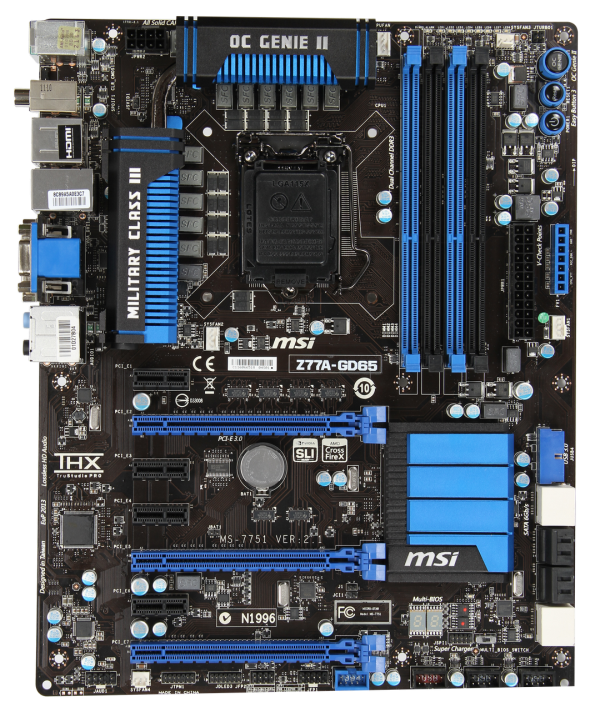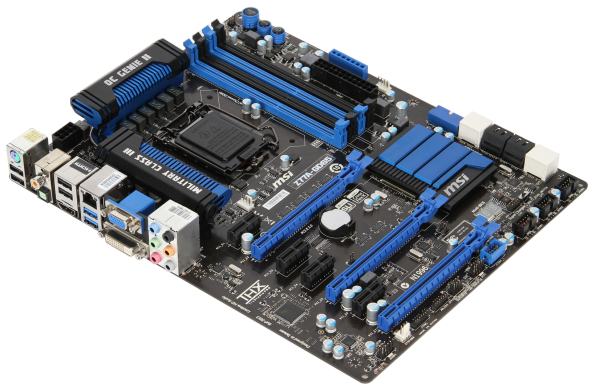Intel Z77 Panther Point Chipset and Motherboard Preview – ASRock, ASUS, Gigabyte, MSI, ECS and Biostar
by Ian Cutress on April 8, 2012 12:00 AM EST- Posted in
- Motherboards
- Intel
- Biostar
- MSI
- Gigabyte
- ASRock
- Asus
- Ivy Bridge
- ECS
- Z77
MSI Z77A-GD65—Visual Inspection
Whenever it comes to a motherboard comparison involving ASUS, Gigabyte or ASRock against an MSI board, the MSI board always tends to show a strong result—either in terms of price, performance or features. So when it comes to the new batch of motherboards for Ivy Bridge, it is fair to say that I expect a strong showing from MSI. For this preview, we have their Z77A-GD65, which will be one behind their future released GD80 that got attention back at CES for being Thunderbolt equipped.
The Z77A-GD65 is another motherboard in this roundup that comes in a black and blue livery. This time MSI have more of an excuse than others do as they have been using it for a fair while now. Using what is essentially a 10 + 2 phase power delivery, MSI are using somewhat beefier heatsinks than their rivals, connecting both via a heatpipe. The socket area is right up against Intel's minimum requirements from left to right, but there is some room to maneuver big air coolers from top to bottom. Around the socket there are at least four fan headers to use: one 4-pin CPU header between the top VRM and the memory slots, a 4-pin system fan header just the other side of the memory slots, a 4-pin to the bottom left of the socket area, and another 4-pin beside the 24-pin ATX power connector. A fifth fan header can be found at the bottom of the board.
Along the right hand side, we have the standard MSI trio of power/reset/OC Genie buttons, followed but a series of voltage checkpoints for overclockers. Aside from the 24-pin power connector and the system fan header, there is also a USB 3.0 header at right angles to the board, indicating its primary use is to the front of the case. Underneath this are the eight SATA ports—two SATA 6 Gbps from the PCH, four SATA 3 Gbps also from the PCH, and another two SATA 6 Gbps from an ASMedia controller.
As the power/reset/OC Genie buttons are at the top right, the bottom of the board has more room to fit in all the headers as needed—front panel audio, TPM, front panel headers and USB 2.0 headers. In terms of PCIe, MSI have done away with the PCIe to PCI bridge and focused purely on PCIe. We have an x1, x16 (x8 with dual GPU), x1, x1, x8, x1, and a PCIe 2.0 x4. In this instance, there is plenty of room for a dual GPU setup with PCIe slots to spare for any extras.
Also of note is the chipset cooler, which is very flat and large with minimal fins, perhaps suggesting that MSI is confident about their heatsink design. Underneath this is a two digit debug display, and a BIOS switch for changing between two BIOSes.
On the rear IO panel, I think MSI have been reasonable with what they have left in and what they have left out. From left to right, we have a combination PS/2 port, two USB 2.0 ports (black), a clear CMOS button, digital and coaxial SPDIF outputs, two more USB 2.0 ports (black), a HDMI port, gigabit Ethernet, two USB 3.0 ports (blue), D-Sub, DVI-D, and audio jacks.
Board Features
| MSI Z77A-GD65 | |
| Size | ATX |
| CPU Interface | LGA-1155 |
| Chipset | Intel Z77 |
| Power Delivery (CPU/iGPU) | 8 + 1 + 2 + 1 (VRM/VTT/GPU/SA) |
| Memory Slots |
Four DDR3 DIMM slots supporting up to 32 GB Up to Dual Channel, 1066-2667 MHz |
| Video Outputs | HDMI, DVI-D, D-Sub |
| Onboard LAN | Intel 82579V |
| Onboard Audio | Realtek ALC898 |
| Expansion Slots |
2 x PCIe x16 Gen3 (x16, x8/8) 1 x PCIe x16 Gen2 (x4) 4 x PCIe x1 Gen2 |
| Onboard SATA/RAID |
2 x SATA 6 Gbps (PCH), Support for RAID 0, 1, 5, 10 4 x SATA 3 Gbps (PCH), Support for RAID 0, 1, 5, 10 2 x SATA 6 Gbps (ASMedia ASM1061) |
| USB |
4 USB 3.0 ports (2 back panel, 2 from headers) 10 USB 2.0 ports (4 back panel, 6 from headers) |
| Onboard |
4 x SATA 6Gbps 4 x SATA 3 Gbps 1 x USB 3.0 Header 3 x USB 2.0 Headers 1 x IEEE1394 Header 1 x TPM Header 1 x Front Panel Audio Header Power/Reset Buttons OC Genie 5 x Fan Headers |
| Power Connectors |
1 x 24-pin ATX connector 1 x 8-pin 12V connector |
| Fan Headers |
1 x CPU Fan Header (4-pin) 4 x SYS Fan Headers (two 4-pin, two 3-pin) |
| IO Panel |
1 x Combo PS/2 Port 1 x Clear CMOS Button 1 x Coaxial S/PDIF Port 1 x Optical S/PDIF Port 4 x USB 2.0 2 x USB 3.0 1 x Gigabit Ethernet Audio Jacks 1 x HDMI 1 x DVI-D 1 x D-Sub |
| Warranty Period | 3 Years |
| Product Page | Link |
It is good to see an Intel NIC on this $180 MSRP motherboard. There are plenty of headers to go around. The only things missing where other motherboards may have better all-round functionality are a PCI slot, mSATA and on-board WiFi.













145 Comments
View All Comments
DanNeely - Monday, April 9, 2012 - link
This is similar to what happened with the USB1->2 transition. The newer controller is significantly bigger (read more expensive) and very few people have more than one or two devices using it per computer. I suspect the 8x (Haswell) chipset will be mixed as well; simply because the total number of ports on the chipset is so much higher than it was a decade ago (vs older boards were all but the lowest end models added more USB from 3rd party controllers).ASUSTechMKT - Monday, April 9, 2012 - link
mSATA currently has very little penetration on the market and cost wise it is much lower to purchase a larger cache SSD for the same or lower cost. We would prefer to focus on bringing implementations that offer immediate value to users.As for the Intel nics all our launch boards across the board for ATX ( Standard and above all feature Intel lan ) we have been leading in this regard for a couple of generations.
In regards to USB 3 we offer more than the standard on many boards but keep in mind many users only have 1 USB3 device.
jimnicoloff - Sunday, April 8, 2012 - link
Maybe I missed something from an earlier post, but could someone please tell me why these don't have light peak? Are they waiting to go optical and it is not ready yet? Having my USB3 controlled by Intel instead of another chip is not enough to make me want to upgrade my Z68 board...repoman27 - Sunday, April 8, 2012 - link
Thunderbolt controllers are relatively expensive ($20-30) and their value is fairly limited on a system using a full size ATX motherboard that has multiple PCIe slots. Including two digital display outputs, an x4 and a couple x1 PCIe slots on a motherboard provides essentially all the same functionality as Thunderbolt but at a way lower cost.ASUSTechMKT - Monday, April 9, 2012 - link
Almost all of our boards feature a special TB header which allows for you to easily equip our boards with a Thunderbolt add on card which we will release at the end of the month. Expect an approximate cost of $40 dollars, this card will connect to the TB header and install in a X4 slot providing you with Thunderbolt should you want it. A great option for those who want it and for those who do not they do not pay for it.DanNeely - Tuesday, April 10, 2012 - link
Sounds like a reasonable choice for something that's still rather expensive and a very niche product.Am I correct in thinking that the mobo header is to bring in the DisplayPort out channel without impacting bandwidth available for devices?
jimwatkins - Sunday, April 8, 2012 - link
I've made it this far on my venerable OC Q6600, but I can't wait any longer. I do wish they weren't so stingy on the 6 core as I could use it, but I just can't justify the price differential (w 3 kids that is.)androticus - Sunday, April 8, 2012 - link
USB 3.0 descriptions and depictions are contradictory. The platform summary table says there are 4. The Intel diagram shows up to 4 on front and back (and the diagram is itself very confusing, because there are 4 USB 3.0 ports indicated on the chipset, and then they show 2 going to hubs, and 2 going directly to the jacks.) The text of the article says there can only be 2 USB 3.0 ports.What is the correct answer?
mariush - Sunday, April 8, 2012 - link
I think there's 2 real ports (full bandwidth ports) and the Intel solution uses 2 additional chips that act like "hubs", splitting each real port into 4 separate ports.Basically the bandwidth of each real port gets split if there are several devices connected to the same hub.
Hub as far as I know means that what the hub receives sends to all four ports (and then the devices at the end of each port ignore the data if it's not for them).
This would be different than a switch, which has the brains to send the data packages only to the proper port.
plamengv - Sunday, April 8, 2012 - link
DZ77GA-70K makes DX79SI looks like a bad joke (which it is really).LGA 2011 turns into an epic fail and DZ77GA-70K is the proof. I have 1366 system and I have zero will to get LGA 2011 system thanks to the crappy tech decisions somebody made there. Six cores is the top? Again? An old 32nm process? Really? Chipset with nothing new inside but troubles? Since 1366 something strange is going on and Intel fails to see it. The end user can get better manufacturing tech for the video card than for the CPU. First it was 45nm CPU with 40nm GPU and now 28nm GPU and 32nm CPU and Intel call that high end? Really?
Everything that DX79SI should have been you can find inside DZ77GA-70K.
1. DZ77GA-70K has high quality TI 1394 firewire controller, while DX79SI has cheap VIA one that no any audio pro would ever want to deal with.
2. DZ77GA-70K has next best after Intel SATA controller by Marvell to get 2 more SATA 6.0 and eSATA vs zero extra SATA and hard to believe no any eSATA on DX79SI.
3. Intel USB 3.0 vs crappy Renesas.
DZ77GA-70K has everything to impress, including the two Intel LANs vs the Realtek that everyone else is using.
DZ77GA-70K fails in only one thing - it had to be LGA 2011, not 1155 that will be just 4 cores like forever and has zero future.
Wake up INTEL!